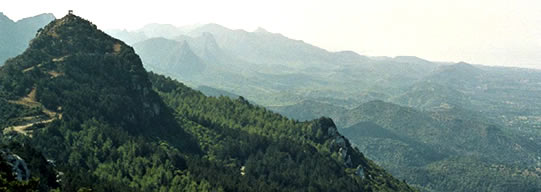
Kantara, is situated at the Eastern end of the Kyrenia Range (2,068 ft.). It is 26 miles North of Famagusta reached via Iskele and Ardahan villages. The castle is 2 miles east of the summer resort which is also called Kantara (1,800 ft.).
The natural features of Cyprus create a vast range of sports and activities to choose from. The Cyprus mountains are favourite hiking and mountain biking destinations. The Cyprus Tourism Organisation publishes excellent free maps and guides in English, German and other languages. Being an island Cyprus also offers all sorts of water sports: diving, sailing, fishing, wind surfing and canoeing. Other popular sports in Cyprus are golf, horse riding, tennis and during the winter months skiing.
Also local tour operators and most hotels can help you book a mountain bike tour, horse back riding, a dive course, a sailing boat or other activities during your stay on Cyprus.
Cyprus offers activities all year round: diving, golf, sailing, hiking, mountain biking, skiing, horse riding. For those who seek relaxation and pampering there are plenty of spa and health centres around Cyprus.
“The arch”
Kantara means a bridge or arch in Arabic probably so named by the Arab invaders in the past. In fact the whole setting of the terrain looks like an arch and it certainly commands excellent views of the seas on both sides and of long stretches of plain all around it. It was originally built by Byzantines against the invasions of the Saracens. The Lusignans called it Candare or La Candaire. They remodelled and enlarged these fortifications.
History of Kantara Castle, North Cyprus
Kantara Castle first appears in records during the time of the Crusades of Richard the Lionheart. Indeed, it is said to be the castle where Isaac Komnenos surrendered to Richard in 1191. In 1228, Kantara Castle was besieged by royalists, who bombarded the walls with catapults so badly that they had to be almost completely rebuilt.
During the time of the Genoese attacks in Famagusta, Kantara Castle became a refuge for those escaping the fighting. (The prince of Antioch escaped from Famagusta to Kantara Castle with the help of his faithful cook!) In more peaceful times, the Lusignan kings themselves would come to Kantara Castle to hunt in the mountain forests, pursuing the local mountain goats with tame leopards.
Like the other two castles in the Kyrenia Mountains (St Hilarion Castle and Buffavento Castle), the Venetians took over Kantara Castle, but abandoned it in 1525 because the castle was so remote. The ruins you can see today at Kantara Castle date from the 13th century, and the picturesque remains include towers, walls and a defensive barbican. The word “kantara” means arch in Arabic, and the castle is built on one, making the castle only accessible from one direction.
Structure of the Castle
The Castle is entered from the east where the cliff is less steep and allows an access. The entrance is about in the centre of the eastern outer wall and was protected on both sides by two rectangular towers of which only tile parts survives.
In the south tower are now arranged the latrines. The outer wall ended to the North and the South in two shoe-horse shaped tower with loopholes. Climbing the steps, the visitor having entered the barbican reaches the inner entrance of the castle which is in the centre of a strong wall which ends in two huge towers at the North and South.
The visitor entering the inner entrance and turning to the left comes to the Southeast tower , a large rectangular room covered with a cross vault. The basement of this room, which has now been turned into a cistern for rain water storage, was , at first used as a prison. Leaving this tower the visitor comes to a vaulted room . Following the path to the south comes to a range of three vaulted chambers with loopholes. At the Southeast end of those chambers is the Mediaeval latrine. Following the path to the Southwest the visitor sees the remains of the South wall and on the right a shoe-shaped cistern .Further to the west on the left are the remains of a tower and on the right the remains of other chambers and cisterns.
The west part of the southern wall of the castle ends in a shoe-horse shaped tower and continues at the west of the cliff with three vaulted climbers. In the most Southerly chamber there is a small gate which was used by the garrison in an emergency. In the Northern side of the West part there are another two vaulted chambers.
Following the steep path on left are the remarks of the Byzantine Northern wall with cisterns and other ruined chambers. From here the view of the Northern Coast of Cyprus is majestic.
Leaving the Northern wall of the Castle that entrances the steep cliff, the visitor may visit the chamber on the top of which the South wall with its beautiful window stands almost intact (2068 ft.) The Mediaeval Guard of the Castle used this tower not in order to enjoy the view but in order to exchange messages with the guard on Buffavento Castle.
Descending the tower of the summit to the North-East direction the visitor arrives at the North-East two storeyed tower which commands the entrance and control the movements in the North Sea. An entrance in the Eastern Wall leads to the shoe-horse shaped vaulted tower. The top floor of this tower ended with a rectangular chamber. Leaving this tower the visitor following the path on his left, comes to the inner entrance of the Castle.
Picnic at Kantara Castle, North Cyprus
Kantara Castle makes a great day out for the family, but come prepared. The only refreshments available are at the Kantara restaurant in the village itself. Alternatively, stock up with a picnic in Famagusta and enjoy the picnic and barbecue sites available at the nearby forest station.



